
The 2025 edition of Apple’s highest-end iPhone is the iPhone 17 Pro Max. I’ve been using one since it first went on sale this past Friday morning to put it through its paces. The improvements over last year’s iPhone 16 Pro are few in quantity but important in quality. There is a new design that works better when the iPhone performs complicated tasks, plus it feels great in your hand. The camera system is substantially improved, with the first 8x optical zoom on an iPhone and a clever approach to the front-facing camera. Plus, you get more battery life and more RAM. Moreover, considering that most folks upgrading to this device have been using something even older than last year’s iPhone 16 Pro, they are going to see many more improvements. In short, this device is excellent.
If you can’t stand the heat…
The most noticeable change with this year’s model is the look. No, I’m not talking about the new orange color option, which is the color featured in much of Apple’s advertising. I’m talking about the back and the sides.

Apple used a single sheet of aluminum to create much of the enclosure. Here is what it looks like, using a still frame from a video created by Apple:

This new unibody design results in a number of advantages. Here is an overview, provided by Apple:
The new brushed aluminum unibody design is crafted with a lightweight aerospace-grade 7000-series aluminum alloy to deliver the best-ever thermal performance in an iPhone. On the back, the plateau creates additional space for internal components — making room for a larger battery. The antennas are integrated around the perimeter for the highest-performing antenna system ever in an iPhone.
Let’s break that down. First, the thermal performance. Apple has always used its best processor in the Pro version of the iPhone. This year, it is the A19 Pro chip. John Velasco of Tom’s Guide ran some tests and found that this chip is about 13% faster in single core tasks and almost 20% faster in multicore tasks than the A18 Pro that Apple used one year ago.
Any high-end processor produces heat when it provides maximum performance. For the last few years, I’ve noticed that the iPhone can get rather hot to the touch when this happens. And this also has an impact on performance. There have been times in the past when I have used an iPhone Pro to do something intensive, like record 4K HDR video for a long time in an area with poor cellular service, causing the modem to also push itself to the max, and the heat has caused the iPhone to substantially dim the screen to try to compensate for the overheating. The dimmer screen makes it hard to see what the camera is recording. This year, the single piece of aluminum of the unibody is designed to spread that heat more evenly across the body of the iPhone to help the iPhone cool down more quickly.
And that’s not all. Apple also designed a new vapor chamber. This article by Gwendolyn Rak of IEEE Spectrum provides technical details on how Apple’s vapor chamber works. Better yet, Aldo of Know Art studios released this excellent video a few months ago to show how the vapor chamber in a non-Apple smartphone works and is manufactured, and I’m sure that this is similar to what Apple is doing:
Apple says that the vapor chamber it designed seals deionized water inside the chamber, and then that vapor chamber is laser-welded into the aluminum chassis. The two systems work together to move heat away from the A19 Pro processor and distribute that heat evenly throughout the aluminum unibody. This allows the A19 Pro processor to operate at even higher performance levels while keeping the surface of the iPhone cooler in your hand.
It is easy to notice the difference. When I push this new iPhone to the limit, the body of the iPhone does get warmer, but not nearly as hot as prior models. And I have yet to see this new iPhone get so warm that it needs to dim the screen—although, to be fair, I’ve only been using it for a few days, so perhaps I will see that at some point in the future.
Better battery
The front of the iPhone 17 Pro Max looks the same as last year’s model. In the following picture, the newest model is on the right. I can only tell the difference by seeing at the top that my iPhone 16 Pro Max no longer has cellular service because I moved that service to the iPhone 17 Pro Max, which has two bars of service:

However, the new unibody design changes the shape of the back of the iPhone. Instead of a camera bump on just the top left, the camera plateau on the new model stretches from side to side:
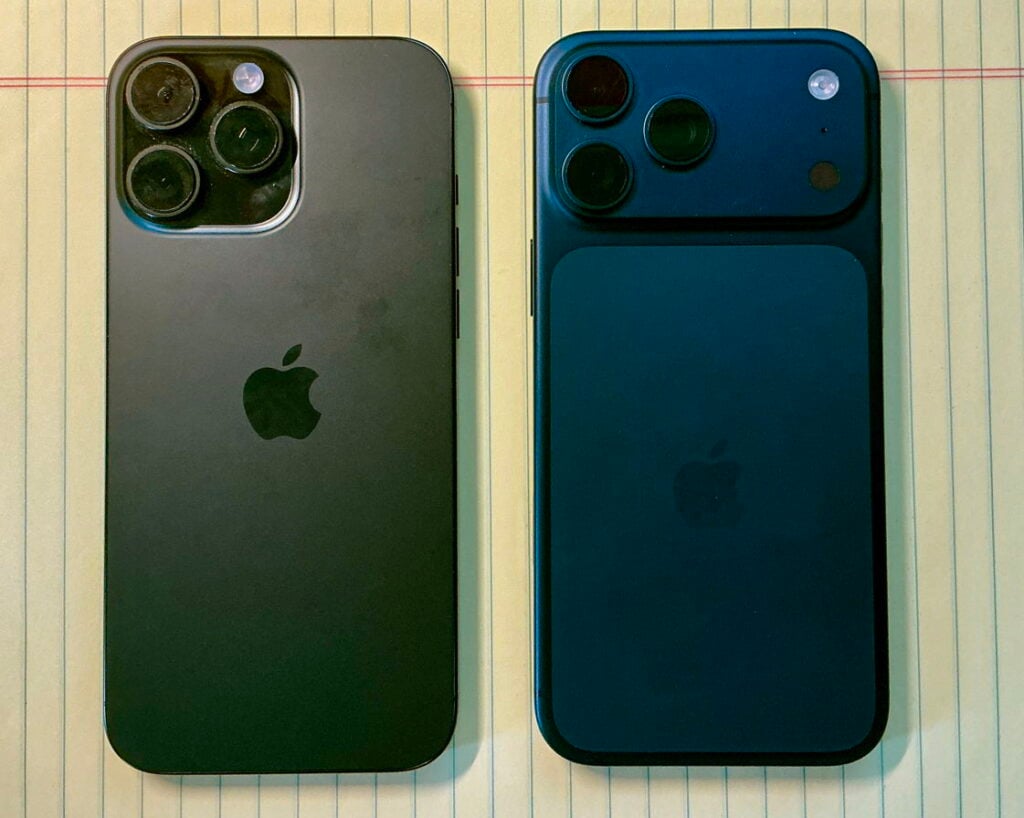
Apple says that this additional space is used to put an even larger battery inside. This contributes to the iPhone 17 Pro Max being slightly heavier than last year’s model—8.22 ounces versus 7.99 ounces—and it provides more battery life. Apple says that video playback on the iPhone 16 Pro Max is up to 33 hours, whereas that increases to up to 39 hours on the iPhone 17 Pro Max. I rarely need more than 33 hours between charges, but of course, other tasks use up the battery much more quickly, so having even more battery life for those tasks is a luxury.
When it is time to recharge, all three new iPhone models introduced by Apple this month can recharge faster when you use a new $39 power adapter from Apple called the 40W Dynamic Power Adapter with 60W Max. Those new iPhone models and that adapter work together to provide a faster charge for a period of time, after which it then charges like other 40W chargers. As a result, you can get to a 50% charge in 20 minutes, which Apple says is about 10 minutes faster than before. I don’t have this new adapter, so I couldn’t test it. I’m curious if third parties, like Anker, will be able to incorporate this feature into their chargers.
Better feel
When Apple designed the shape for this new unibody design, it provided just slightly more curve around the edges. It is a subtle difference that I’m having difficulty photographing, but this still frame from a video created by Apple shows it:
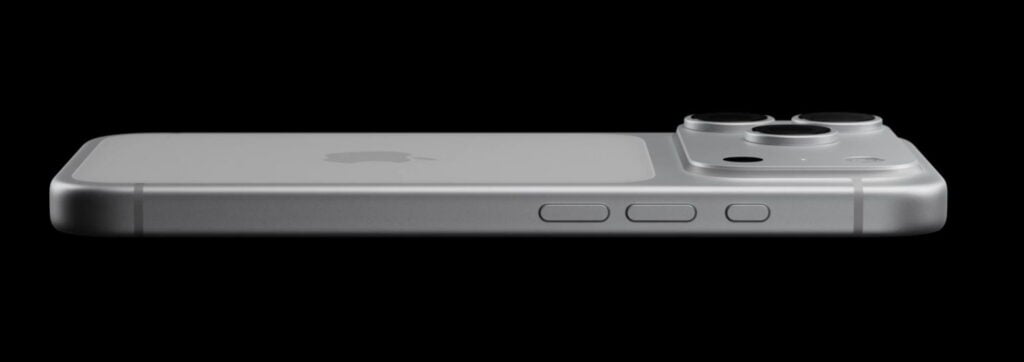
Trust me, you can really feel it when you hold this device in your hand. In my opinion, this is the best feeling iPhone that I can remember using. It is incredibly comfortable to hold, but the slight curve at the corners doesn’t make it too slippery to hold. Considering that this is a device that I will hold in my hand countless times every single day, I’m a big fan of this new design.
More durability
Two years ago, Apple released the iPhone 15 Pro, changing the body from stainless steel to titanium. Apple said that titanium was lighter while remaining very strong. This year, the body is made of aluminum. However, because it is a single unibody, and because Apple has also used its new Ceramic Shield 2 technology to protect both the glass on the front of the iPhone and the back of the iPhone, Apple says that this year’s model is more durable than ever. Apple says that this design is more resistant to scratches and cracks.
More nits, less glare
The screen is improved in two ways. First, peak brightness when outdoors goes from 2000 nits (iPhone 16 Pro Max) to 3000 nits (iPhone 17 Pro Max). That makes the iPhone easier to read on a bright day, and it is a welcome improvement.
Second, the Ceramic Shield 2 on the front of the iPhone uses improved anti-reflection technology to reduce glare. The improvement is noticeable. In the following picture, compare the light fixture reflected on the screen of the iPhone 16 Pro Max (left) and the iPhone 17 Pro Max (right).
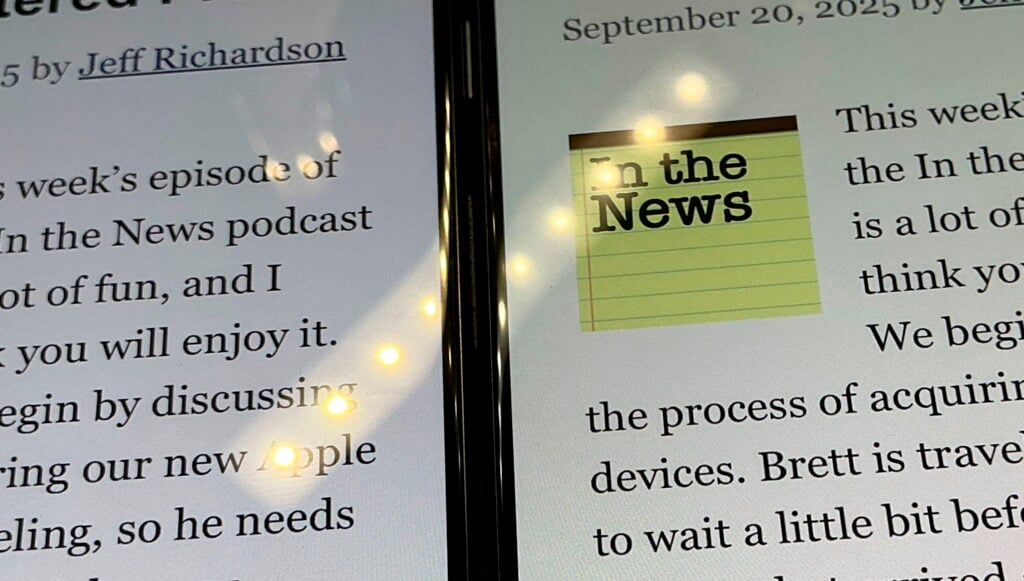
Each LED is brighter when reflected on the screen of the iPhone 16 Pro Max. And the rectangle reflected from the lamp around the LEDs is far more pronounced when reflected on the iPhone 16 Pro Max versus the iPhone 17 Pro Max.
8x optical zoom at 200mm
The most noticeable change to the camera system on the back of the iPhone 17 Pro models is the 8x optical zoom, which is equivalent to a 200mm zoom on an SLR camera. A 200mm zoom is a common zoom lens for an SLR camera because it provides quite a bit of magnification, but not so much that you absolutely need to use a tripod to keep the camera perfectly still. First, I want to address how Apple achieved this 8x optical zoom … but I have actually already done that. So allow me to just repeat what I wrote earlier this month when Apple first announced the iPhone 17 Pro:
I like to take pictures and videos, so a major reason that I pay more for a Pro model is the better cameras. Last year, the iPhone 16 Pro and Pro Max featured three cameras on the back: a 48MP (megapixel) Ultra Wide camera (for 0.5x), a 48MP Fusion Main camera (for 1x and 2x), and a 12MP Telephoto camera (for 5x). This year, the main camera stays the same. The Ultra Wide camera now gains “Fusion,” which is the term Apple uses when the camera takes both a 12MP picture (to maximize light capture) and a 48MP picture (to capture fine detail) and then fuses those into a single 24MP image. In other words, photos that you take with the 0.5x lens should be better with this model.
Instead of last year’s 5x camera, this year there is a 4x camera. But that’s not a step down; it’s actually a step up. That’s because the telephoto camera on the iPhone 16 Pro was only a 12MP camera. The new iPhone 17 Pro telephoto camera is a 48MP camera. What this means is that the iPhone can use all 48MP to give you a 4x zoom, or can focus on just the 24MP in the middle to give you an 8x zoom. Yes, it is true that is cropped from the 4x image, but the 8x 24MP photo should be a step up from last year’s 5x 12MP photo. I often find it very useful to have a zoom lens. A zoom lens that is both better quality (48MP or 24MP versus 12MP) and a higher magnification (8x versus 5x) sounds great to me, and I cannot wait to try it out. The range from 0.5x to 8x is 16x, so you get a ton of flexibility on how you want to frame your shot.
Apple says that the 8x mode is equivalent to a 200mm focal length. Before I shifted to the iPhone for virtually all of my photography, I previously used a Nikon DSLR camera, and I really loved Nikon’s Superzoom lens, which went from 18mm to 200mm. When David Pogue was writing for the New York Times, he would frequently praise that lens, such as in this article from 2007. While I enjoy the 5x zoom on my iPhone 16 Pro (120mm equivalent), going up to 8x (200mm equivalent) seems like a substantial improvement. Of course, with that much zoom, it will be even more important to hold the camera very steady, but Apple has always done a great job with image stabilization software, and I’m sure that Apple has incorporated that into the 8x mode.
So how does the 8x lens work? It works great. Here are a series of pictures that I took in my backyard of a folk art sculpture that my wife and I purchased years ago at the art market at the New Orleans Jazz Fest. These images go from a 0.5x (the wide-angle lens) to the new 8x lens. I’ve reduced the size and compressed these images so that they are not too huge on this website, so keep in mind that the quality of the actual images is better than what you are seeing here. But this still gives you a good sense of the image quality. And more importantly, it shows you how you can compose a completely different picture even though you are standing in the same location.
The 0.5x and 1x lenses show the art in the context of the backyard.
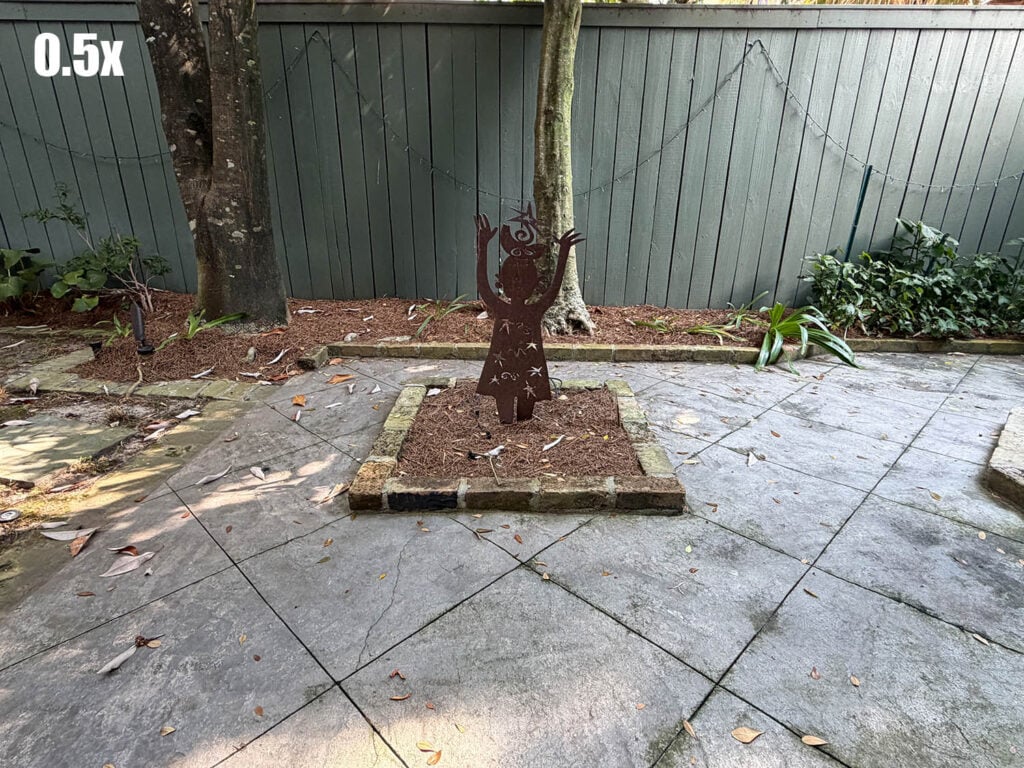
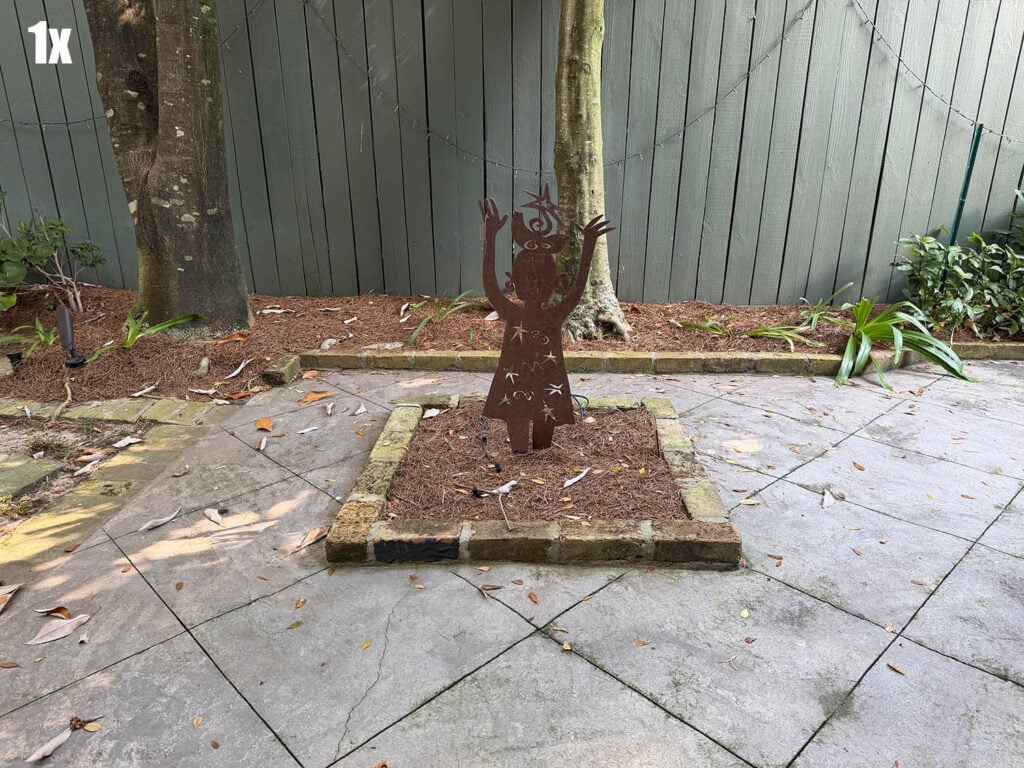
At 2x, the focus of the picture is the art itself.

At 4x, the focus is on the upper half of the girl’s body.

At 8x, the focus is on the face.

Each picture tells a different story, and with a 16x range, from 0.5x to 8x, you have lots of choices without using the crop feature to sacrifice image quality.
Here’s one last picture for comparison. To take this picture, I moved my iPhone so close to the face of the art that the Macro feature of the camera was triggered:

It is no surprise that by moving my camera much closer, I can capture more detail than with the 8x zoom. But the 8x lens gets me almost as close to the object as I got with this Macro picture. If you want a close-up picture and you have the ability to get your camera right on top of the object, then of course, use the Macro feature of the 0.5x lens, the lens that Apple calls the Ultra Wide lens. But if you don’t have that ability, the 8x Telephoto lens can get you closer than ever before.
Here is another example. From my office window, I can look down to see the front of the federal court district court building in New Orleans, the Eastern District of Louisiana. There is an area just in front of the entrance where members of the media often congregate to try to interview attorneys as they leave the courthouse and/or to show the attorneys walking out of the courthouse on the news. I’ve handled some high-profile cases over the years where I have gotten quite good at providing no comment as I walked through this area when that was what my client wanted. Using the 1x Main camera on the iPhone, I can see the building but can only barely make out that area. With the 8x lens, I can easily see this area, including the steps and the flagpole. Again, your picture can tell a completely different story when you have this much flexibility in composing your shots.
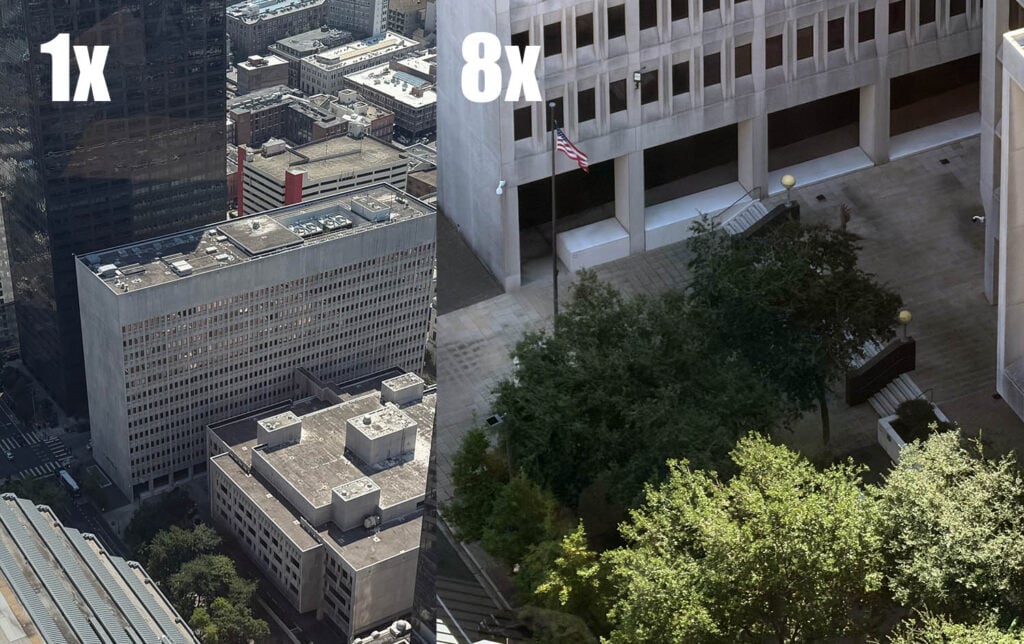
I know that I will use all of these different cameras and zoom levels on the back of the iPhone 17 Pro Max. It is great to have lots of good options.
Better selfies
Apple has also provided a new camera system on the front of the iPhone. Apple calls this the Front Camera. Everyone else calls this the Selfie camera. Once again, let me start by repeating what I said earlier this month about what is different:
The front-facing camera—the selfie camera—is also better in multiple ways. First, it is an 18 megapixel square camera instead of a 12 megapixel 4×3 camera. I don’t believe that you can actually take square pictures with this new camera. But what you can do is hold your iPhone in portrait orientation, making it easier to hold in your hand, and take a landscape photograph. And this camera really shines when combined with a new software feature: Center Stage. In the past, Apple has had Center Stage on certain Macs and iPads. It means that the camera can essentially “zoom in” on you, unless multiple people are in the frame, in which case it will “zoom out” to show everyone. You may start taking a selfie picture in the traditional portrait orientation mode, but then if others join you in the picture, the Camera app is smart enough to switch to a landscape orientation mode to keep everyone in the picture.
That better front-facing camera has another trick up its sleeve. If you are taking a video with a camera on the back of your iPhone, you can simultaneously take a video with the front-facing camera. Thus, not only can you have a video of your daughter shooting a three-pointer in a high school basketball game, but you can also film your reaction at the same time. (My daughter’s varsity basketball team just started practices for the 2025-26 school year, so you can understand why that is on my mind.) I want to learn more about how this works. Can I take video with both cameras but then choose only to use the video from the back camera, either some of the time or all of the time? We’ll have to see how it works, but it is an interesting idea. Note that this improved front-facing camera on the iPhone 17 is also used on the iPhone Air and the iPhone 17 Pro models.
Although I don’t use the Front Camera on the iPhone very often, these are nice improvements. I especially like that you can take pictures in landscape orientation while still holding the iPhone in portrait orientation—which gives you a much better grip on your iPhone. The Front Camera will automatically switch from portrait to landscape mode when others come next to you, using the Center Stage feature. But you can also just tap a button on the screen to switch from portrait to landscape mode. I like this feature.
As for simultaneously taking video with the front and back cameras, Dual Capture is an interesting feature, but I don’t think it is for me. I would like the idea of capturing the Front Camera as I film an event using the back camera if, for some specific moment where I and others had a fun reaction, I could show it. But that’s not how the feature works. When you take a video using this Dual Capture, you can decide whether the inset showing you is at the top or bottom, left or right. Here is an example from Apple’s website:
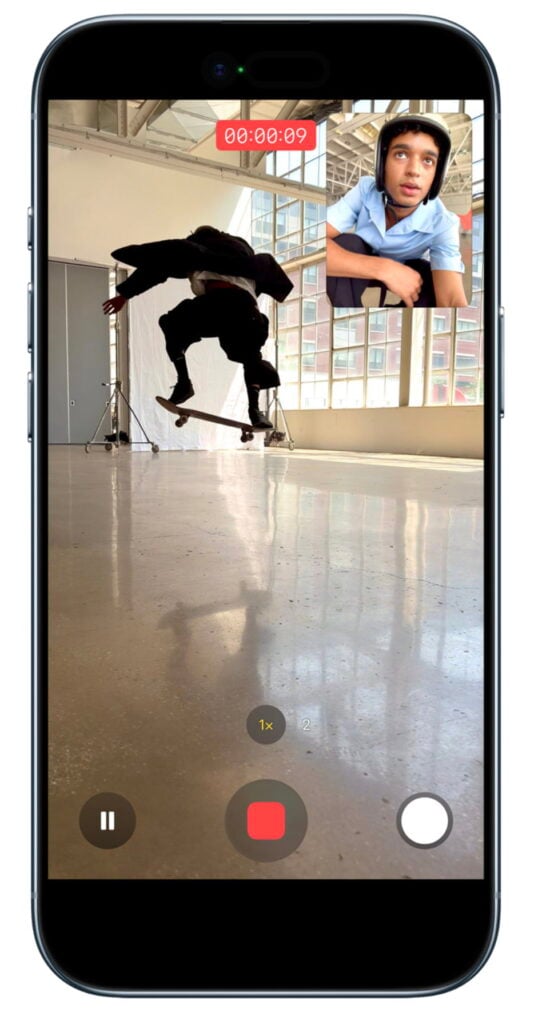
However, once the video is saved, that inset is a permanent part of the video. If you film your daughter playing basketball using Dual Capture, every time you watch the video in the future, you will have to see your own face during the entire game. If that doesn’t bother you, then you might like this feature. And perhaps I will even find a specific circumstance when I will use it. But at this point, I don’t know when that would be.
More RAM
Apple has never advertised how much RAM is used by different iPhone models, which is curious because it is better to have more RAM. You can have more browser tabs open, more apps can run in the background before they close, AI works better with more RAM, etc.
Joe Rossignol of MacRumors reports that the iPhone 17 Pro and Pro Max both have 12GB of RAM. The iPhone 15 Pro and iPhone 16 Pro both had 8GB of RAM, so that is 50% more. The iPhone 12 Pro, 13 Pro, and 14 Pro had 6GB of RAM.
To the Max
The iPhone 16 Pro and iPhone 16 Pro Max are identical except for screen size. The only other difference is that if you want a 2TB model, which is available for the first time this year, that is only an option for the iPhone 17 Pro Max.
In 2023, I decided for the first time to try out the “Max” iPhone size when I purchased an iPhone 15 Pro Max. It does take a little time to get used to the larger and heavier iPhone, but I got used to that long ago. And as someone who has always had poor eyesight, I prefer having a larger screen with the Display Zoom set to Larger Text (located in Settings -> Display & Brightness). So I decided to get the Max version again this year, but I understand that many people will prefer the smaller size of the iPhone 17 Pro, especially this year when the two devices are otherwise virtually identical.
Wireless networking
For the first time ever, Apple is making its own wireless networking chip instead of buying one made by another company, such as Broadcom. Apple calls this the N1. It controls Wi-Fi, Bluetooth, and Thread. It supports the latest versions of those standards—Wi-Fi 7 and Bluetooth 6—and Apple says that the N1 chip “improves the overall performance and reliability of features like Personal Hotspot and AirDrop.”
I haven’t had an opportunity to notice these improvements yet, but it makes sense to me that a wireless networking chip designed by Apple specifically for the iPhone is going to be better than something that someone else designs for any smartphone.
Colors
I always prefer getting a black iPhone because I want the device itself to fade away into the background, with all of my focus on the (impressive) iPhone display. For the first time since the original iPhone was released in 2007, that isn’t an option this year. So instead, I opted for the next best thing: the Deep Blue color. It is a very nice color, but I still would have gone for black if that were an option.
The other two color options are Silver and Cosmic Orange. Cosmic Orange has many people excited. It is the first time ever that Apple has offered a vibrant color for a Pro iPhone. I looked at this color when I was in the Apple Store this past Friday, and I understand the appeal. If you like orange, and/or if you like making a statement with the color of your iPhone, you’ll like Cosmic Orange. I applaud Apple for adding Cosmic Orange this year.
But does orange have to be the new black? Dear Apple: next year, please give me the option to select black.
Even more for many folks upgrading
In much of this post, I’ve compared the iPhone 17 Pro Max to the iPhone 16 Pro Max because that is what I had been using. Plus, it makes sense to focus on year-to-year improvements. But I suspect that most folks considering an upgrade this year will be coming from an older iPhone.
If you have an iPhone 15 Pro Max, you’ll see additional improvements, including (1) a smaller bezel and larger display (6.9-inch instead of 6.7-inch), (2) the Camera Control button, (3) better microphones, (4) an ever larger improvement in battery life, and (5) an even more substantial improvement in the processor. If you have an iPhone 14 Pro Max, you’ll see even more improvements, including (1) the Action button, (2) an even bigger telephoto lens improvement, from 3x to 8x, and (3) a USB-C port instead of Lightning.
Cost
The iPhone 17 Pro starts at $1099 for the 256GB model. If you want the Max version with the larger screen, you pay $100 more. Going up to 512GB adds $200; going up to 1TB adds $400. I had been using a 512GB model in the past, but I like the idea of being able to store even more video on my device, so this year, I went for the 1TB model.
If you need the most storage, this year, Apple is offering a 2TB iPhone 17 Pro Max for $1999.
Conclusion
I get a new iPhone every year, and I always appreciate the improvements. This year is no exception. This year’s model feels great in the hand, has the best performance ever, has a great 8x telephoto lens, has a better display, is more durable, has tons of battery life, and has other nice improvements like the new Front camera and more RAM. If you decide that this is a good year for you to upgrade, the iPhone 17 Pro and iPhone 17 Pro Max are excellent devices that I think you will love.
